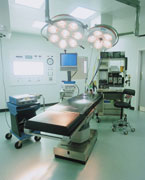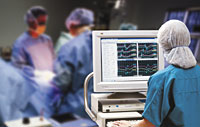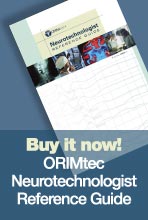Hospital Administrators
In this section:
 ORIMtec offers hospitals and other healthcare providers an exciting medical/technical service that is conducted in the operating room and is known as intraoperative neurophysiological monitoring (IONM). IONM provides critical, real time data to surgeons, anesthesiologists, and other OR personnel during the surgical process to enhance communications and assist with timely decisions. IONM has proven valuable in:
ORIMtec offers hospitals and other healthcare providers an exciting medical/technical service that is conducted in the operating room and is known as intraoperative neurophysiological monitoring (IONM). IONM provides critical, real time data to surgeons, anesthesiologists, and other OR personnel during the surgical process to enhance communications and assist with timely decisions. IONM has proven valuable in:
- Reducing chances of permanent injury during head, neck and spine surgeries.
- Facilitating successful surgical outcomes and patient safety.
- Decreasing potential risk for hospitals and surgeons as well as operational costs.
If you are a hospital administrator, this section will introduce you to IONM and explain how surgical monitoring can benefit your hospital, your surgical service, and your patients. You may also want to visit the FOR PATIENTS and FOR SURGEONS sections to review the information provided for patients facing surgery, along with their physicians.
IONM OVERVIEW
 Intraoperative neurophysiological monitoring (IONM) is a real-time assessment of neurological function involving the spinal cord and related nerve structures during surgical procedures. IONM is commonly conducted in the operating room during neurosurgery, spinal surgery and neurovascular surgery. Complex, multimodality monitoring can facilitate the timely use of critical neurological data during the surgical procedure.
Intraoperative neurophysiological monitoring (IONM) is a real-time assessment of neurological function involving the spinal cord and related nerve structures during surgical procedures. IONM is commonly conducted in the operating room during neurosurgery, spinal surgery and neurovascular surgery. Complex, multimodality monitoring can facilitate the timely use of critical neurological data during the surgical procedure.
- Using IONM, an ORIMtec-trained neurotechnologist (NT) can assure the surgeon that nerve integrity remains intact at critical junctures or alert the surgeon to compromising situations should they occur.
- Failure to address nerve compromise may result in irreversible neurological damage, exposing the patient, surgeon and hospital to significant risk.
- Armed with information about changes in the conduction of electrical impulses, the surgeon can take appropriate corrective action before neurological injury becomes permanent.
- Surgical monitoring by a well-trained neuromonitoring team benefits not only the surgeon, but also the hospital and insurance companies by:
- Allowing surgeons to complete more aggressive surgeries safely.
- Enabling hospitals to reduce risks and costs and better utilize operating room time.
- Lowering payor healthcare costs by reducing the number of second surgeries, therapies, scans, and prescriptions that may be necessary when desired outcomes are not achieved.
Most importantly, IONM allows surgeons and hospitals to provide patients with the best possible care so that they can experience a better quality of life through enhanced surgical outcomes.
CHIEF EXECUTIVE OFFICER
All hospital administrators share a number of common issues and interests for which the addition of intraoperative neuromonitoring (IONM) to the surgical service should be considered:
- Patient safety and a higher percentage of successful surgeries.
- Reduced procedure times to facilitate increased operating room utilization.
- Evidence of nerve integrity via the documentation of conductivity during surgical procedures.
Given the public expectation that quality and safety will be proven, in your role as the Chief Executive Officer, you may want to consider using IONM to achieve a higher standard of patient care. IONM can help you to actualize the benefits of monitoring and minimize the risks associated with head and spine surgical procedures. ORIMtec has substantial internal data, which is also supported by general medical literature, to demonstrate the value of IONM.
CHIEF MEDICAL OFFICER
The Value of IONM
As Chief Medical Officer, you will most likely find that the opinions of your surgeons vary regarding the implementation and use of intraoperative neuromonitoring (IONM). Those surgeons who embrace IONM are educated in its application and have most likely observed or worked with a well-trained neuromonitoring team practicing complex, multi-modality monitoring. This type of surgical monitoring employs all of the appropriate diagnostic tools at the proper time. Knowing what modality to use and when separates ORIMtec from the marginal monitoring groups. ORIMtec uses only well-trained neurotechnologists (NTs) to assist your surgical staff in achieving the best possible outcomes for your patients.
IONM has been studied and well-documented for the past 30 years. There is substantial literature on the merits of its use. For example, reports show that the incidence of neurological complications associated with placement of pedicle screws runs as high as 10 percent. In one study, "The Usefulness of Electrical Stimulation for Assessing Pedicle Screw Placements," Journal of Spinal Disorders, Vol 13, No.4 (2000) no new neurological deficits were reported in a group of 662 monitored patients. ORIMtec's internal data suggest potential abnormalities of 12% in cases utilizing pedicle screws.
While somatosensory evoked potentials provide information on the sensory nerve pathways, the introduction and acceptance of motor evoked potentials (MEPs) completes the monitoring picture by evaluating the motor pathways as well. The publication, "Comparison of Transcranial Electric Motor and Somatosensory Evoked Potential Monitoring During Cervical Spine Surgery" Journal of Bone and Joint Surgery, Vol. 86-A, No. 6 (2004) supports the value of motor pathway monitoring. More surgeons are using IONM as they become educated about the advantage of MEPS on operations in the cervical region.
Additional Considerations
Neurotechnologist (NT) Training: Douglas M. Enoch, MD, MS, has been instrumental in developing our Quality Assurance and Qualification Guidelines. Dr. Enoch received his graduate certificate in neurological surgery from the Mayo Clinic and Masters of Science degree in Neurophysiology from the University of Minnesota and has over 30 years of neurosurgical experience.
Remote Monitoring Capability: Physicians trained in IONM provide the supervisory role to ORIMtec neurotechnologists (NTs) through online, real-time remote monitoring. Further details regarding how this supervision is accomplished can be found in the REMOTE MONITORING section under FOR SURGEONS.
Public Policy Issues: Marc R. Nuwer, MD, PhD, from the Department of Neurology at the School of Medicine at UCLA Medical Center, discusses professional public policy issues relevant to IONM in, "Regulatory and Medical-Legal Aspects of Intraoperative Monitoring" Journal of Clinical Neurophysiology (2002). Dr. Nuwer addresses billing, coding, reimbursement, staffing, device approval, and liability issues connected with intraoperative neuromonitoring.
CHIEF NURSE EXECUTIVE
As a Chief Nurse executive, it will be reassuring to know that all ORIMtec neurotechnologists (NTs) are board-certified or board-eligible in neurophysiological monitoring (CNIM) in intraoperative neuromonitoring (IONM). NTs earn their certification through the American Board of Registration of Electroencephalographic and Evoked Potential Technologists, Inc. (ABRET).
In addition to CNIM, ORIMtec NTs are trained in many other aspects of the OR environment.
- Having knowledge of protocol and sterile techniques allows NTs to perform their job in the OR without being disruptive and with respect to sterile fields.
- Understanding the role and function of each medical player in the OR enables NTs to interact as true team members during the surgical procedure.
Teaching effective communication skills remains paramount to ORIMtec. Our NTs have been specifically trained to communicate effectively in the OR with the entire team, including the circulating nurse, surgical technologist, anesthesiologist, and surgeon.
We also provide quality assurance forms for every case we monitor on a quarterly basis. Having these forms can help your JCAHO inspections go more smoothly.
CHIEF FINANCIAL OFFICER
Today CFOs are looking to provide services more efficiently while maintaining optimal patient care. With the advent of new techniques and improved computer technology, intraoperative neuromonitoring (IONM) has become the standard of care in most medical communities. ORIMtec's internal data suggest that cases using IONM, when conducted by a well-trained neurotechnologist (NT), can shorten OR time, decrease complications, and shorten hospital stays--all valuable in the current fixed-payment environment of healthcare.
ORIMtec contracts for IONM services with numerous hospitals throughout Northern California and Southern Oregon. We negotiate fees for our technical services with each hospital independently.
ORIMtec statistics support the fact that potential abnormalities are detected in approximately 12 percent of low back surgeries. The incidence of neurologic complications associated with placement of pedicle screws has been reported as high as 10 percent, as discussed in "The Usefulness of Electrical Stimulation for Assessing Pedicle Screw Placements" Journal of Spinal Disorders, Vol. 13, No. 4 (2000). The findings in this article support IONM as an inexpensive, reliable method for protecting neurological function.
OPERATING ROOM DIRECTOR and RISK MANAGER
A permanent neurological deficit may lead to an expensive and time consuming resolution process for you. In spinal surgeries, negative outcomes commonly result in neurological problems than can be serious or even permanent. Even if the deficit can be corrected, the hospital frequently realizes additional expenses. Lawsuits and settlements resulting from less-than-optimal spinal surgery outcomes are costly. The costs for a surgery resulting in quadriplegia are not only financially horrendous for the provider, but personally painful for the patient whose quality of life can be drastically impaired.
Intraoperative neuromonitoring (IONM) can reduce the potential for these negative outcomes. Neuromonitoring can help lower costly risk or additional expenses by identifying the deficit in advance, and allowing for corrective action to be implemented in a timely manner. As Nancy Epstein, MD, reports in her article, "Evaluation of Intraoperative Somatosensory-Evoked Potential Monitoring During 100 Cervical Operations" Spine Vol. 18, No. 6. Intraoperative neurophysiological monitoring has contributed to the reduction of neurologic injury from 4 – 6.9% down to 0 – 0.7%, a substantial improvement.


